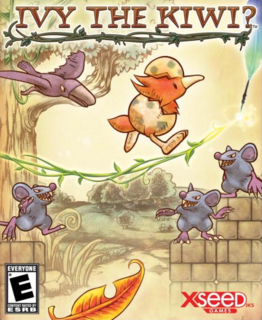Beneath this game's pleasing veneer lies a satisfyingly challenging experience.
If that sounds menacing, then I've successfully conveyed the level of challenge present in Ivy the Kiwi. (Okay, so that last line is rather hyperbolic. You get the point, though.) Rather than be a deterrent, however, the relentless challenge is the appeal. Much like the bullet-hell variety of shooters, Ivy the Kiwi is a game that revels in its difficult nature, making no compromises whatsoever for the sake of accessibility. Harsh? Perhaps, but it's that no-holds-barred attitude that makes Ivy the Kiwi endearing and immensely rewarding.
What exactly the game is from a gameplay standpoint is hard to say. It doesn't really fall under any of the conventional labels. Classifying it through such would be a disservice. To put it simply, Ivy is a game of guidance. You're given no direct control of the adorable titular, fiery red, eggshell clad bird with whom your charged with babysitting; she moves on her own, pressing onward constantly without regard for whatever danger lurks ahead. Your role is guide Ivy through the 100 plus perilous, obstacle-ridden levels using vines, which you can call out of thin air wherever you like.
The Wii remote pointer is your means of interaction. Holding down the A button summons a vine that you can stretch in any direction and place by letting go of the button, with the pointer directing where it moves. It's swift and intuitive control, if a touch inaccurate, complimenting the manic pace of the game.
You wouldn't know it by looking at screenshots or listening to its cheery soundtrack, which betrays the manic nature of the gameplay with its controlled pace and mix of cheery and moody tunes to match the static background images that accompany each new world, but this game is very frenetic.
The game climbs in difficulty at a fair and steady clip -- the first couple of worlds are almost effortless, requiring little from you to achieve success -- it doesn't take long for it to start upping the ante. In terms of obstacles, the first real threat are spiked walls, which are easily rendered threat-less by placing some vines before them to act as barriers. Then enemies, both ground and airborne, are introduced. Then blocks that can only be destroyed by boulders, as opposed to using Ivy as a bullet for a makeshift slingshot made of vines. Then drops of water that somehow inexplicably kill. Then all of it gets thrown together, at which point you begin to curse the developers for their fiendish level designs as the whole game begins conspiring against you.
When you combine all of the above and put them into tight, intricate courses, and add a three-minute time limit on top of that, you get Ivy the Kiwi at its finest: remarkably fast and devilishly challenging. Replete with obstacles around every corner, you're forced to react quickly and with the utmost accuracy to survive each course. The game moves so fast, however, that accurately placing vines on the fly is a very trying task, particularly when trying one of the more advanced techniques. For instance, using vines to catapult Ivy upward over spiked floors or simply ascend. Even when propelled upward, Ivy continues to move left or right, granting not even a hint of solace throughout her journey.
That's journey being a search for her mother, presumed to be missing. The set-up is that Ivy wakes up in a forest clearing, one day, freshly hatched from her egg, and doesn't see her mom anywhere. Panicked, she sets of looking for her mother, which leads her through a number of static locales such as a city, the frigid lands of the mountaintops, and the sky itself. Nothing stops this bird. She's on a mission and she ain't stopping for no one, regardless of the many dangers ahead. She's a tough bird to manage, therefore, forcing you to be comparatively speedy with the vine dropping to have any hope of guiding her safely.
Again, trial-and-error is a crux component. Death is inevitable, and with each failure comes greater understanding of how to proceed, that knowledge bringing success closer and closer. Frustration starts setting in after the fourth or fifth consecutive failure -- doubly so when you die right on the cusp of victory -- but that also makes your eventual triumph much more satisfying. Overcoming the many obstacles before Ivy is exercise in vexation oftentimes, teetering on the border of impossible in a couple levels, even. The strong sense of satisfaction you get from finally getting past that choke point that's been tormenting you for the past half-hour counters the immense dissatisfaction of failure perfectly.
Finishing the story once, which should take around 5-8 hours depending on your level of skill, unlocks a slightly harder version of the story mode for your masochistic pleasure. From there, you may also partake in some competitive multiplayer for up to four players in a race to see who can finish a level first. You can also replay individual levels to improve your score, improve your time, and find all of the feathers dispersed throughout. All of them do a fine job of extending the game's longevity.
They say you shouldn't judge a book by it's cover; Ivy the Kiwi is easily a perfect example of such. It seems like a children's game on the surface, what with the storybook narrative and cutesy art style, but in reality it's well suited for just about anyone -- particularly those with a penchant for playing nail-bitingly hard games. It's an enjoyable little game, if a bit on the vexing side, but that's just part of Ivy's charm.

